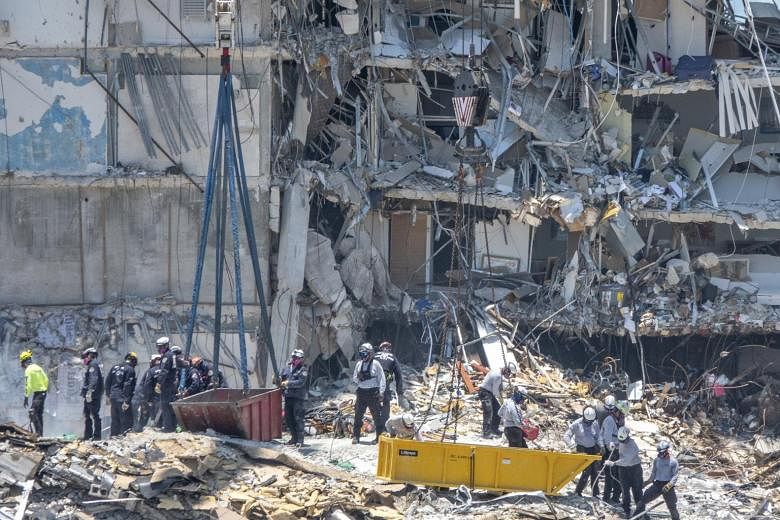SURFSIDE, FLORIDA (NYTIMES) - The investigation into what may be the deadliest accidental building collapse in American history has just begun, but experts who have examined video footage of the disaster outside Miami are focusing on a spot in the lowest part of the condominium complex - possibly in or below the underground parking garage - where an initial failure could have set off a structural avalanche.
Called "progressive collapse", the gradual spread of failures could have occurred for a variety of reasons, including design flaws or the less robust construction allowed under the building codes of four decades ago, when the complex was built.
But that progression could not have occurred without some critical first failure and close inspections of a grainy surveillance video that emerged in the initial hours after the disaster have given the first hints of where that might have been.
"It does appear to start either at or very near the bottom of the structure," said Mr Donald Dusenberry, a consulting engineer who has investigated many structural collapses. "It's not like there's a failure high up and it pancaked down."
The early examinations came as rescuers on Sunday (June 27) spent a fourth day pushing through the enormous heap of debris created when half of the 13-storey building, Champlain Towers South, fell away early last Thursday.
The death toll climbed to nine as additional remains were found, while more than 150 people remained unaccounted for.
While a number of bridges, overpasses and buildings under construction fail each year, the catastrophic collapse of an occupied building - in the absence of a bomb or an earthquake - is rare, and investigators are struggling to understand how it could have come with so little urgent warning.
"It would be like a lightning strike happening," said Mr Charles Burkett, the mayor of Surfside, Florida, where the collapse occurred. "It's not at all a common occurrence to have a building fall down in America. There was something very, very wrong with this situation."
The National Institute of Standards and Technology, a federal agency, was sending scientists and engineers to do a preliminary review, hoping to identify and preserve materials that might help understand the collapse. Officials said they expected a number of local, state and federal agencies to also be involved in the inquiry, though it was not clear which agency would lead the effort.
The search for an explanation comes with a sense of urgency not only for sister buildings near the complex but also for a broad part of South Florida, where a necklace of high-rise condominiums, many of them decades old, sits on the edge of the Atlantic Ocean, enduring an ever-worsening barrage of hurricane winds, storm surge and sea salt.
Structural engineers were shocked that a building that had stood for decades would abruptly crumble on an otherwise unremarkable summer night.
But three years before the deadly collapse, a consultant found alarming evidence of "major structural damage" to the concrete slab below the pool deck and "abundant" cracking and crumbling of the columns, beams and walls of the parking garage under the building.
From what can be seen in the video, part of the structure first slumped, seemingly falling vertically in one giant piece, as if the columns had failed beneath the southern edge of the centre of the building, not far from the pool.
Like a nightmarish avalanche, the failure quickly spread and brought down the entire centre of the building. Seconds later, a large section to the east also toppled.
While no definitive conclusions could be drawn from the surveillance video, which was shot from a distance and reveals only one perspective of the disaster, some of the engineers reviewing it last week said it seemed to suggest that the failure began at a specific point near the bottom of the structure - perhaps as far down as the parking garage beneath the building, or on the first few floors.
Mr Dusenberry, whose impressions matched those of several other structural engineers who examined the video, said such a failure "would suggest a foundation-related matter - potentially corrosion or other damage at a lower level". But he said it was not certain that corrosion was the culprit and added that "you certainly can't rule out a design or construction error that has survived for 40 years".
Mr Rick De La Guardia, an engineer based in Miami with experience in forensic investigation of buildings, said that the collapse could have also started higher than the foundation, possibly on the second floor, based on his cursory review of the columns in the floor plans and his review of the video.
Explanations for an initial failure at the bottom of the building could include a problem with the deep, reinforced concrete pilings on which the building sits - perhaps set off by an unknown void or a sinkhole below - which then compromised the lower columns.
Or the steel reinforcing the columns in the parking garage or first few floors could have been so corroded that they somehow gave way. Or the building itself could have been poorly designed, built with substandard concrete or steel - or simply with insufficient steel at critical points.
Dr Evan Bentz, a professor of structural engineering at the University of Toronto, said that the best evidence so far had come from the video and some simple reasoning - pointing a finger of suspicion at the supporting columns in the underground parking garage.
"The primary purpose of all the columns in the basement is to hold the structure up in the air," he said. "Because the structure stopped being held up in the air, the simplest explanation is that the columns in the basement ceased to function."

